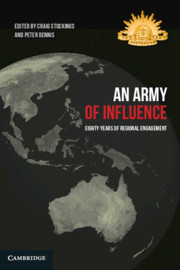Book contents
- An Army of Influence
- Acknowledgement of Country
- An Army of Influence
- Copyright page
- Foreword
- Contents
- Figures, maps and tables
- Contributors
- Abbreviations
- Introduction
- Part 1 The concept of an army’s influence abroad
- Part 2 Lessons from past relationships
- Part 3 Ongoing relationships
- Chapter 9 Access, but how much influence?
- Chapter 10 Australia’s military engagement with Malaysia, 1955–2020
- Chapter 11 Cambodia
- Chapter 12 Was the juice worth the squeeze?
- Chapter 13 Achieving influence through advising relationships
- Chapter 14 Training teams as a force of choice
- Chapter 15 A perspective on diplomacy in the Army’s contemporary regional relationship-building
- Chapter 16 The Army’s patchy engagement with Australia’s near north
- Index
Chapter 10 - Australia’s military engagement with Malaysia, 1955–2020
from Part 3 - Ongoing relationships
Published online by Cambridge University Press: 16 November 2021
- An Army of Influence
- Acknowledgement of Country
- An Army of Influence
- Copyright page
- Foreword
- Contents
- Figures, maps and tables
- Contributors
- Abbreviations
- Introduction
- Part 1 The concept of an army’s influence abroad
- Part 2 Lessons from past relationships
- Part 3 Ongoing relationships
- Chapter 9 Access, but how much influence?
- Chapter 10 Australia’s military engagement with Malaysia, 1955–2020
- Chapter 11 Cambodia
- Chapter 12 Was the juice worth the squeeze?
- Chapter 13 Achieving influence through advising relationships
- Chapter 14 Training teams as a force of choice
- Chapter 15 A perspective on diplomacy in the Army’s contemporary regional relationship-building
- Chapter 16 The Army’s patchy engagement with Australia’s near north
- Index
Summary
In 1961, the 2nd Battalion, Royal Australian Regiment (2RAR), was placed under the command of the 1st Malaya Infantry Brigade and tasked with combined security operations in northern Malaya, later called Malaysia. An important occasion, this was the first time Australian soldiers had been commanded by their Malaysian partners. While significant, this was not surprising. Australian infantry battalions had spent the previous six years supporting the United Kingdom–led response to the Malayan Emergency. Alongside Malayan, British and several Commonwealth nations, the Australians undertook extensive jungle patrols, ambushes, convoy protection and food security operations as part of the United Kingdom–led counterinsurgency to defeat communist terrorists. Commitment, respect and partnership were defining features of Australian military engagement during this period and remain so through to this day.
- Type
- Chapter
- Information
- An Army of InfluenceEighty Years of Regional Engagement, pp. 220 - 244Publisher: Cambridge University PressPrint publication year: 2021

